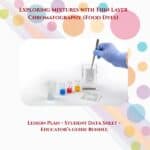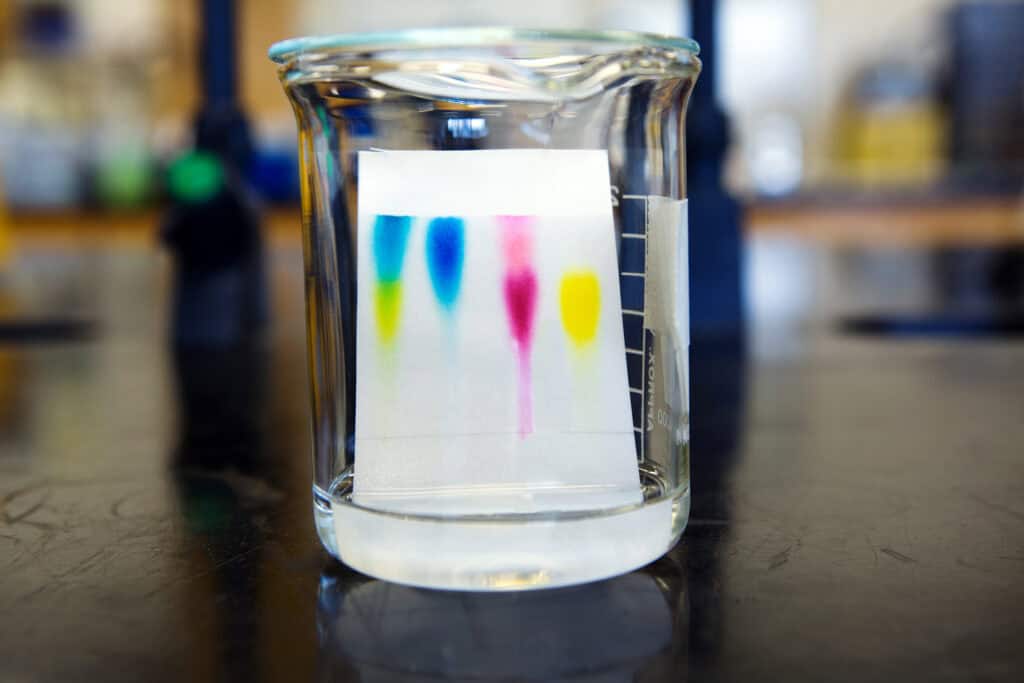Thin Layer Chromatography (TLC) is one of the most approachable yet powerful chromatography techniques. Building on the foundations of paper chromatography, TLC offers clearer results, faster separations, and more flexibility for scientists in the lab as well as learners in the classroom.
Thin Layer Chromatography: A Brief History
Thin Layer Chromatography (TLC) emerged from scientific curiosity and collaboration, with key figures shaping the method over decades. The foundational breakthrough occurred in 1938, when Russian scientists N.A. Izmailov and M.S. Schreiber first used thin layers of adsorbent—spread onto slides—to separate plant extracts visually, spotting ring-shaped zones as the solution diffused outward.
In the 1940s, advances continued as J.G. Kirchner and colleagues at the U.S. Department of Agriculture tackled the chemistry of orange and grapefruit flavours. Frustrated by tough separations, they adapted techniques from recent publications, combining silicic acid and starch to create a satisfactory TLC layer on glass plates. Kirchner’s lab was instrumental in standardising TLC procedures, steering it toward modern reproducibility and reliability .
Another major innovator, Egon Stahl of Germany, pushed TLC’s capabilities even further. In the late 1950s, Stahl developed and commercialized silica gel plates that offered remarkable consistency and sensitivity, unlocking the method’s potential for widespread use in analytical laboratories. Stahl’s leadership produced both technical advances—like optimal particle size and plate coating—and extensive guides for TLC applications.
By the 1960s, with pre-coated plates easily available commercially, TLC had become a standard technique beloved for its simplicity and effectiveness. The journey from Izmailov and Schreiber’s initial experiments to Stahl’s industrial innovations marks TLC as a collaborative triumph, marrying inventive methods and practical tools for generations of chemists.
How Does Thin Layer Chromatography Work?
The principle of TLC is simple: compounds separate based on how strongly they interact with two phases—the stationary phase (a thin layer of silica or alumina on a glass, plastic, or metal plate) and the mobile phase (a solvent or solvent mixture that moves up the plate). These are the steps below.
- A small drop of the sample mixture is spotted near the bottom of the plate.
- The plate is placed upright in a shallow container of solvent.
- As the solvent travels up the plate by capillary action, the different compounds move at different rates.
- The result is a series of separated spots, each corresponding to a different component of the mixture.
- By measuring the distance a compound travels compared to the solvent front (the Rf value), scientists can identify and compare substances.

This is very similar to the hands on science chromatography activity we have done here on Insanitek. That was done with paper chromatography, while thin layer is done with different solvents and chemicals on a hard plate.
Why Use Thin Layer Chromatography?
TLC is widely valued because it is fast, versitile, inexpensive and simple. Results appear in minutes, making it perfect for checking reactions or teaching demos. It can analyse dyes, plant pigments, pharmaceuticals, inks, and more. TLC plates and solvents are affordable, and the method requires little specialised equipment. Easy to visualise results—many pigments show up as coloured spots, and invisible compounds can be revealed with UV light or chemical stains.
Because of its accessibility, TLC is often the first chromatography method students encounter after paper chromatography.
Real-World Applications
TLC finds use in both education and professional science:
- Education: Demonstrating separation of markers or plant pigments in a classroom experiment.
- Pharmaceuticals: Checking purity of drugs or identifying active ingredients.
- Art Conservation: Analyzing dyes and pigments in historical artworks.
- Forensics: Detecting substances in inks, poisons, or drugs.
Its quick turnaround and low cost make it an ideal tool for rapid checks before committing to more advanced techniques like HPLC.
 You can get this lesson plan in the shop for Pay What You Want Pricing. In it you’ll find a step by step lab that gets students doing their first separations, how to read and interpret the results, and ways to extend it to higher levels. There is both a teacher guide as well as the student lab so you can teach with confidence — either from a class or from the kitchen.
You can get this lesson plan in the shop for Pay What You Want Pricing. In it you’ll find a step by step lab that gets students doing their first separations, how to read and interpret the results, and ways to extend it to higher levels. There is both a teacher guide as well as the student lab so you can teach with confidence — either from a class or from the kitchen. Looking Ahead
Thin Layer Chromatography represents an important step in the evolution of chromatography techniques. It combines simplicity with scientific rigor, making it valuable to students, educators, and professional scientists alike. In the next installment of this series, we’ll move from the flat plate of TLC to the more versatile column chromatography, exploring how vertical separation expanded possibilities for analytical chemistry.
Stay tuned as we keep peeling back the layers of chromatography, one technique at a time.
